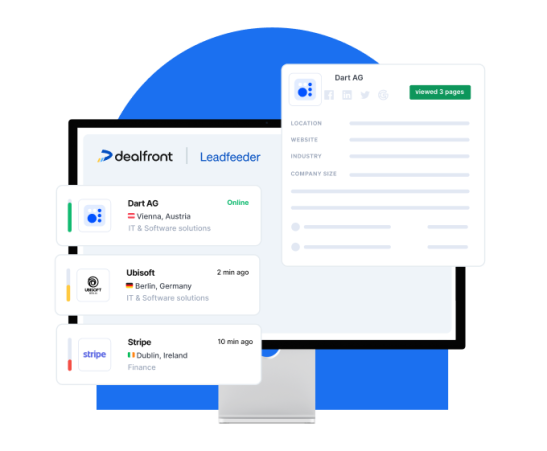Do you want to increase conversion rates and get the most out of your marketing budget? If so: intent data might be the magic fix you're looking for.
By collecting intent data, you can find out exactly what your ideal customers are looking for. What topics they are interested in, what questions they have, and what problems they need to solve.
In this guide, you'll learn everything you need to get started with intent data – what it is, why it's crucial for B2B companies, and what tools you can use to implement it.
Let's take it step by step, starting with the basics.
What is intent data?
Intent data is information that reveals the online behavior of prospects, indicating their potential interest in buying a product or service. The data includes actions like website visits, content downloads, keyword searches, and social media interactions.
In B2B marketing and sales, intent data is commonly used to identify the buyer intent of prospects.
Buyer intent is the likelihood of a potential customer purchasing a product based on their actions indicating readiness to buy. There are several reasons why B2B companies should use intent data:
Increased conversion rates: By focusing their sales and marketing efforts on leads that have demonstrated buyer intent, companies are more likely to experience higher conversion rates.
Better customer retention: By understanding your existing customers' evolving needs, you can proactively engage with them, offering relevant upgrades or complementary solutions. This not only strengthens your relationship with existing clients but also maximizes the lifetime value of each customer.
Optimized marketing budget: By concentrating marketing efforts on prospects actively expressing interest, companies can optimize their marketing budgets, improving the return on investment (ROI).
Competitive advantage: Being proactive in responding to buyer intent can provide a competitive advantage, allowing your company to stay ahead of the competition. A whopping 97% of B2B marketers believe intent data will provide brands with a competitive advantage.
Alignment of sales and marketing teams: Intent data aligns sales and marketing teams by enabling better lead prioritization and fostering a common understanding of customer needs, ensuring more effective collaboration and resource allocation.
First-party vs. third-party intent data
There are two types of intent data:
First-party intent data
This is data companies collect themselves, for example, from their website, email, and other online platforms. It provides information about how users interact with the company's content, what pages they visit, and what actions they take.
Third-party intent data
This type of data is collected by external sources, providing insights into the online activities of prospects on other websites and platforms.
If you're looking to buy third-party data, make sure to pick a provider that is GDPR-compliant. Also, pay attention to the quality, timeliness, and traceability of the data's origin.
Now, let's break down how you can identify buyer intent using first-party and third-party intent data.
How to identify buyer intent through first-party intent data
You can use your first-party intent data collected from your own channels and platforms to identify the likelihood of a prospect making a purchase.
Here are 5 indicators of buyer intent in prospects collected from first-party intent data:
They consume your content: For example, reading an article on your blog or downloading an ebook on your website. You can measure page visits and time spent on the page to understand which content is most popular.
They visit your product or pricing page: If a prospect visits your product or pricing page, it's a clear sign of interest in understanding your product or service better in order to make a purchase decision.
They visit your profile or interact with your posts on social media: Social media platforms like LinkedIn allow you to see when prospects show an interest in you or your products and services. Keep an eye on the interactions on your own profile as well as on your company page.
They attend your webinar or event: Prospects often attend webinars or events to get a better impression of a company's products or services without obligation.
They subscribe to your newsletter: Subscribers to your newsletter can be potential customers but also current customers who are open to upselling. Measure opening rate and clicks for more insights into buying intent.
How to identify buyer intent through third-party intent data
Next up is the data collected outside of your own channels and platforms. Now, this is when it gets really interesting!
Let's break down 3 indicators of buyer intent in prospects collected from third-party intent data:
They visit review platforms: B2B companies often compare tools on review platforms, such as Capterra or G2, to see what other users think of a product or service. Does this mean that you can get information about which prospects are comparing your offer to your competitors? Yes, that's exactly what it means!
They visit your competitors' websites: Wouldn't it be interesting to know who's visiting your competitor's websites? Of course it would be! There's a big chance that prospects visiting your competitor's websites are looking for a product or service that you also provide – making them your target audience as well. You can also prevent churn by keeping an eye on if your customers are checking out competitors' websites. If they do, you can reach out to them in time and do what you can to prevent them from leaving. Great! How do I get my hands on this data? You might ask. There are several different tools you can use to access third-party data. We'll cover the details of this further down!
They search for the solution you're offering: Third-party intent data makes it possible to identify users who are searching for keywords related to the product or service you're offering. This is what we call buyer intent keywords.
Let's dive into that real quick before we move on to the finale: how B2B companies can use intent data to increase growth.
What are buyer intent keywords?
Buyer intent keywords are words or phrases that indicate an intention to buy a product or service; prospects use them when searching on Google (and other search engines).
By tracking the volume of buyer intent keywords, you can create a better understanding of the demand for your product or service. You can also discover which prospects are searching for specific keywords by accessing third-party intent data.
Implement these keywords in your SEO strategy and create content that draws potential customers (with buyer intent) to your website organically.
Buyer intent keywords can be organized into 3 categories based on where the prospect is in the customer journey:
Keywords in the research process (informational keywords) In the first category of buyer intent keywords, prospects are searching for questions like 'what,' 'who,' 'where,' and 'how'. These keywords signal a low purchase intention since the prospects are most likely at the beginning of the customer journey. Examples of words and phrases in this category are 'How do I get more B2B leads?' and 'What is outbound sales?'. If you want to rank for these keywords, create informational content in a guide format, providing the reader with valuable tips.
Keywords in the decision-making process (navigational keywords) Prospects using navigational keywords are looking specifically for a product or service to buy. At this point, they are diligently comparing offerings and searching for things like 'Tools for B2B lead gen' and 'Tool A vs. Tool B'. Content for this category can be customer case studies and comparison guides, something that emphasizes the unique benefits of your product. Promoting free trials is also common in this phase of the customer journey.
Keywords in the buying process (transactional keywords) In the last phase, transactional keywords signal a very specific buyer intent. Here, prospects often search for 'the best way to buy Tool A' or 'Discount for Tool B. This is where you get to go all in and use your content to promote offers for your product or service.
That was that; now, let's get into how you can implement the usage of intent data to improve your marketing and sales efforts!
5 ways all B2B companies can (and should) use intent data
Customer retention and up-selling: Intent data isn't just for acquiring new customers; it can also be valuable for retaining and upselling existing customers. Monitor the online behavior of your current clients to identify signs of potential upsell opportunities or indications that they may be considering additional products or services.
Lead scoring and prioritization: Integrate intent data into your lead scoring model to identify and prioritize leads that are showing a high level of interest or engagement. This allows your sales team to focus their efforts on prospects who are more likely to convert, improving efficiency and maximizing the impact of your sales activities.
Personalized content marketing: Leverage intent data to inform your content marketing strategy. Develop content that aligns with the topics your target audience is actively searching for. This could include creating blog posts, whitepapers, webinars, or other resources that address their current concerns or challenges.
Targeted advertising campaigns: Use intent data to create more targeted and personalized advertising campaigns. By understanding the specific topics or products prospects are actively researching, you can tailor your ads to address their current needs and interests. This can increase the effectiveness of your advertising efforts and improve the chances of conversion.
Sales Enablement: Provide your sales team with intent data to enhance their conversations with prospects. Knowing the specific interests and pain points of a lead allows sales representatives to tailor their pitches and provide more targeted solutions. This can lead to more meaningful interactions, increased customer satisfaction, and higher conversion rates.
Our favorite tools to identify buyer intent
Ready to start collecting and using intent data?
There is a wide range of tools that can help you with this. To give you some guidance, we have selected a few of our favorite data intent tools and divided them into two categories: tools for buyer intent keywords and tools to identify website visitors:
Tools for buyer intent keywords
Wondering which websites your target audience is visiting and what terms they are searching for? DemandJump will give you the answers.
When it comes to keyword research, there are a lot of great free tools out there. We like AnswerthePublic, Thruuu, Keyword Too, and the kwfinder.
Tools to identify website visitors
When users visit your website, it's usually a sign that they're interested in what you have to offer. You can use the following tools to identify otherwise anonymous website visitors and (if they're a good fit) nurture them into customers:
Leadfeeder by Dealfront (works with Google Analytics)
Last but not least, you can use the comparison platform G2 to reveal prospects who are comparing your offer (or a competitor's).
Stay on top of intent data for true business growth
With that said, if you don't use intent data, you're missing out on understanding your target audience. One could even say that you're giving away sales opportunities.
Harnessing the power of intent data is not just a strategy; it's a solid game-changer for B2B businesses looking to stay ahead in a competitive market. The insights derived from intent data provide a roadmap for personalized marketing, targeted sales efforts, and strategic decision-making.
Understanding and leveraging intent data will be the catalyst for unlocking new opportunities, fostering stronger customer relationships, and ultimately securing a lasting competitive advantage!





